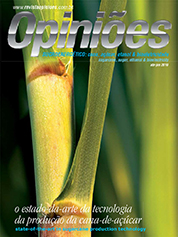Jaime Finguerut
Industrial Strategic Development Manager of CTC
Op-AA-24
Technological progress in sugarcane production
The production of ethanol from fractioned sugar-cane fiber has a very special meaning, implying a radical novelty, which will bring about significant changes throughout the agricultural and industrial sugarcane chain. Starting ethanol production in sugar mills in the 1970’s, through the Proálcool program, caused such mills to develop significantly.
The harvest cycle was extended, sugarcane plantations expanded to new regions (such as the West of the State of São Paulo), requiring overcoming many new agricultural and industrial challenges, while concurrently opening demand for new and improved sugarcane varieties, adapted to production environments. Along with such major changes came the industry’s deregulation, with significant impacts on management.
The introduction of yet another new product - bioelectricity - made possible by the gradual deregulation of electric power generation and transmission in the country, took place in combination with many other changes such as large increases in material and energy efficiency in the mills, stability in supplies, improved knowledge of production techniques and more importantly, significant changes in this business.
Small mills are in a dynamic process of consolidating into groups, family-run management is being replaced by professional man-agement, international capital has started to flow to the industry and finally there is the entry of new players, such as large global commodity and energy companies.
Sugarcane is responding to these new challenges, focusing on the development and use of special varieties that, along with the use of modern biotechnological tools, will make it possible, for example, to accelerate the selection process and the use of high productivity varieties, needed to reduce costs and adapt to new production environments on the agricultural frontier.
A series of new challenges previously believed impossible and related to sustainability have now been presented. Debating international certification, the impact on the production of food, indirect impacts on how land is used, carbon balances and credits, greenhouse gas emissions, the preservation of water springs, cleaner production, social inclusion, Brazil’s international role, among others, all cause impact on sugarcane at the current time and in the immediate future.
Brazilian sugarcane is already one of the most efficient crops, not only because it allows more efficient photosynthesis to take place, but also because it has in the past met, and even now must meet, all such challenges, in a totally transparent and competitive manner. Brazil is already responsible for more than 50% of sugar exports and is also the largest ethanol exporter, having replaced half its national gasoline consumption, to that end using a little more than 10% of its commercially exploited agricultural land, while competing with highly subsidized agriculture in the whole world.
What will sugarcane be like in the cellulosic ethanol age? As occurred upon the introduction of ethanol and bioelectricity, this development is bound to be dramatic. Sugarcane will be responsible for and will enhance the crop’s economic role, in a manner similar to what is expected of the pre-salt layer oil exploration. Brazil is already the world champion in deep-water oil extraction and now intends to extract even more oil from even bigger depths.
Brazil already is the world champion in biofuels based on soluble sugars from cane and now intends to go much further by also using sugars concentrated in cane fibers, which actually entail twice as much energy in comparison with soluble sugars. Thus, since it is not easy to extract oil concentrated in pre-salt layers, although it is necessary and possible and will eventually lead to a totally new industry and a new global leading position for Brazil, cellulosic ethanol too is not easy, but it is possible to extract, and it is already resulting in intensive technological capacitation and new business models.
For instance, see the interest it arouses in this matter in Brazil on the part of large multinational energy companies. However, there is a large difference between oil and cane. Given that sugarcane is a private, open and competitive business, Brazil lacks specific policies for incorporating cellulosic ethanol. All economic agents are active and this is expected to result in a large expansion of the global biofuel market, with the rewarding of the more sustainable options, such as Brazilian ethanol. Energy-cane will look just like sugarcane, perhaps it will be better digestible and contain even more usable energy, even allowing the industry to expand its useful operational lifespan. What no doubt will be quite dif-ferent will be the business activities generated around this new sugarcane.




